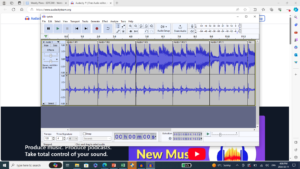I tried the app Audacity for the first time this week. This is an awesome tool that allows you to make your sounds with different objects or sounds tools. I would compare it to moviemaker for music. It allows you to record a sound where you can split, cut, duplicate, and move around to make different sound tracks.

This is what the app looks like. The red button you press to start recording and then press the pause button to stop recording. The two arrows you can use to move frames from as small as a millisecond to make sure your cutting the sound at the right time. If you right click on the line that goes across as your music is playing, it gives you options to delete, split, and many other things that I do not know how to use. I recorded three different cords separately in a song that I learned while playing the ukulele this week. I cut it so that the transition between cords was flawless. I also duplicated each sound and played it in the same pattern to make the song longer. There is so much that you can do on this app that I didn’t get the chance to explore. Although, by just knowing the basics, I was able to make a song I have been struggling play and make it sound decently good. The only problem with this app is that you can only share your audio to one site called audio.com. It is free to sign up and has a lot of different sounds you can use from other creators, but it would be nice to have the option to upload it to more then one platform if needed. Once you have uploaded your song, you can name it, give a description, and post it as public or unlisted, very similar to how you are able to post YouTube videos.
This is the example sound clip I made from my ukulele recording.
I would use this tool in a music and drama class. I would give the kids full autonomy to use whatever instruments or objects they can find to create a song. This would allow them to be able to move the sounds around to make it sound however they want. They can also overlay different sounds to make it sound like more instruments are being played at the same time.
In the SAMR model, I feel modification is the biggest transformation as it allows for the creation of music in class to be significantly redesigned. Instead of having students in groups trying to create something, where a student might not play at the right time or mess up a cord or a note. They can record these instruments and cords individually, and put the song together so that it sounds like there is no mistakes.
Recent Comments